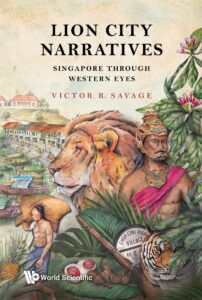About the Book
 Lion City Narratives: Singapore Through Western Eyes fulfils four aims. First, it is a study of subjective Western impressions of Singapore’s 145 years (1819–1963) of colonial history. The study is not meant to be an in-depth historical analysis of Singapore, but rather to give the reader an impressionistic account of how Western residents viewed Singapore over the decades. Second, this study could be seen as a short biography of Singapore’s evolution as a city. The chapters on the imageability of Singapore and its urban morphology provide a holistic perspective of Singapore’s urban dynamics. Third, this book provides a cultural insight into Singapore’s population, both White residents and transient visitors, as well as the locals or Asians. Fourth, it opens a window into Singapore’s development at a time when the West was at its cultural zenith and when Great Britain was the principal superpower of the 19th century. Hence Singapore carried twin colonial legacies – it was the archetype trading emporium between East and West, and it became, for the British, the major point d’appui for defence. Finally, the Singapore colonial narrative is set in a broader academic discourse that allows the reader to see a wider picture of Singapore’s colonial development.
Lion City Narratives: Singapore Through Western Eyes fulfils four aims. First, it is a study of subjective Western impressions of Singapore’s 145 years (1819–1963) of colonial history. The study is not meant to be an in-depth historical analysis of Singapore, but rather to give the reader an impressionistic account of how Western residents viewed Singapore over the decades. Second, this study could be seen as a short biography of Singapore’s evolution as a city. The chapters on the imageability of Singapore and its urban morphology provide a holistic perspective of Singapore’s urban dynamics. Third, this book provides a cultural insight into Singapore’s population, both White residents and transient visitors, as well as the locals or Asians. Fourth, it opens a window into Singapore’s development at a time when the West was at its cultural zenith and when Great Britain was the principal superpower of the 19th century. Hence Singapore carried twin colonial legacies – it was the archetype trading emporium between East and West, and it became, for the British, the major point d’appui for defence. Finally, the Singapore colonial narrative is set in a broader academic discourse that allows the reader to see a wider picture of Singapore’s colonial development.
The book does not attempt to make a definitive statement about the Western involvement in Singapore; it deals more with an association of many subjective Western perspectives that add colour to the liveability of the tropics, perceptions of the exotic Orient, and the myriad views of ethnic groups. Without the Western writings, paintings, and maps, academia would have minimal records of Singapore’s development. As a new colony in the early 19th century however, Singapore’s growth has been extremely well documented.
This book will appeal to Singaporeans interested in understanding Singapore’s colonial past, Westerners interested in the Western cultural persona in the development of Singapore, researchers dealing with the urban development of less-developed countries and colonial development in the tropical world, and lastly, academics who are interested in Singapore and the region’s political and economic development as a case study.
About the Author
 Victor R. Savage is currently an Adjunct Senior Fellow at the S. Rajaratnam School of International Studies (RSIS), Nanyang Technological University, Singapore.
Victor R. Savage is currently an Adjunct Senior Fellow at the S. Rajaratnam School of International Studies (RSIS), Nanyang Technological University, Singapore.
Before joining RSIS in 2017, Dr Savage was a Faculty Member of the Department of Geography at NUS for 36 years. He was also Coordinator of the Southeast Asian Programme at NUS for eight years. At NUS, Dr Savage held many administrative portfolios including Head of Department, Vice-Dean, Acting Dean (FASS), Deputy Chair (Centre for the Arts), Deputy Chair (Master of Environmental Studies), and Director of Alumni Relations. Dr Savage was also a Board Member of the Singapore Environmental Council (SEC), National History Museum, Institute of Southeast Asian Studies (ISEAS), and served on Singapore’s Master Plan and Green Plan. He also drew up the historical masterplan of the Singapore River (2000) for the Singapore Tourism Board. Dr Savage is currently the Chair of the Green Wave Competition sponsored by Sembawang Marine Corporation. Internationally, Dr Savage was Secretary and subsequently, President of the Commonwealth Geographical Bureau (CGB). He was also in the Selection Research Committee of the Asia-Europe Foundation. Dr Savage’s research is focused on Singapore and Southeast Asia in areas of eco-development, urban change, geopolitics and cross-cultural issues.



 Add to Google calendar
Add to Google calendar
 Add to Outlook calendar
Add to Outlook calendar
